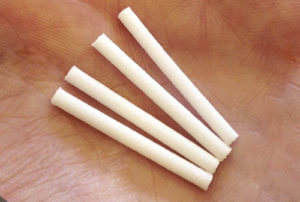 Clinical Series Article. In response to the nationwide opioid epidemic, the FDA has approved the first-ever buprenorphine implant, Probuphine. In comparison with other available forms of buprenorphine, Probuphine offers several clear advantages, which are mostly associated with preventing misuse and abuse of the drug.
Clinical Series Article. In response to the nationwide opioid epidemic, the FDA has approved the first-ever buprenorphine implant, Probuphine. In comparison with other available forms of buprenorphine, Probuphine offers several clear advantages, which are mostly associated with preventing misuse and abuse of the drug.
The Subdermal Implant
The subdermal implant is intended for maintenance treatment of opioid dependence in patients who are stable on no more than 8mg of sublingual buprenorphine (Suboxone or Subutex) per day. According to Titan Pharmaceuticals, the developer of the delivery system, a double-blind clinical study has indicated that patients who were clinically stable on 8mg or less of buprenorphine per day maintained stability when transferred to Probuphine and were more likely to sustain abstinence from illicit opioids throughout the six months than those being treated with sublingual buprenorphine.
The Opioid Agonist
Buprenorphine is an opioid partial agonist, essentially meaning that it binds to the opioid receptors in the brain in such a way that it eases withdrawal symptoms without producing the disorienting high that results from opioid abuse. Because it has both a longer half-life and a greater ability to bind to receptors in the brain than other opioids, buprenorphine can block or greatly reduce the effectiveness of other opioids. This blocking effect is intended to deter patients from returning to the abuse of illicit opioids; however, a patient may simply skip a dose if they wish to abuse another opioid.Once the patient has taken any other type of opioid, taking buprenorphine too soon—less than twelve hours—afterward will strip those opioids off of the brain receptors, sending an opioid-dependent individual into a very uncomfortable state of precipitated withdrawal. Consequently, motivation to return to medication-assisted withdrawal is compromised by the desire to continue using opioids. Furthermore, any buprenorphine that the patient may have left over has a fairly high street-market value, which could be sold or traded to fund further drug abuse. With a subdermal implant, these concerns would not be an issue.
Once the patient has taken any other type of opioid, taking buprenorphine too soon—less than twelve hours—afterward will strip those opioids off of the brain receptors, sending an opioid-dependent individual into a very uncomfortable state of precipitated withdrawal. Consequently, motivation to return to medication-assisted withdrawal is compromised by the desire to continue using opioids. Furthermore, any buprenorphine that the patient may have left over has a fairly high street-market value, which could be sold or traded to fund further drug abuse. With a subdermal implant, these concerns would not be an issue.
Probuphine provides non-fluctuating blood levels of buprenorphine around the clock for six months following a single treatment procedure, according to its manufacturer. This also means that patients would not have to worry about misplacing their medication or forgetting to take a dose, which both can result in very stressful and uncomfortable situations. It could also be the case that maintaining even levels of buprenorphine in the bloodstream, around the clock, may help patients to move away from the addictive thought pattern of always looking forward to the next dose.
According to probuphine.com, Probuphine should be used as part of a complete treatment program to include counseling and psychosocial support. Many addicts have found a spiritual or psychosocial solution for the disease of addiction. Some might argue that, along with complete abstinence and a support group, this spiritual solution is all that one needs to recover. Others say that buprenorphine is a smart way to detox an opioid-dependent individual, as long as the patient is tapered off of the drug rapidly in order to prevent the formation of a new physical dependency to the drug buprenorphine; this also provides an opportunity to establish a foundation for eventual abstinence-based recovery. However, many doctors recommend maintenance therapy, and studies seem to indicate its effectiveness. The truth is, it often takes multiple attempts and various methods to combat the disease of addiction with any measure of success. There is an increasing trend toward using a multi-pronged approach combining evidence-based protocols with a traditional recovery model.

